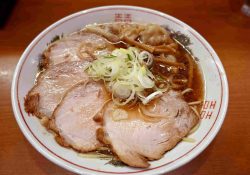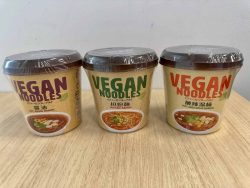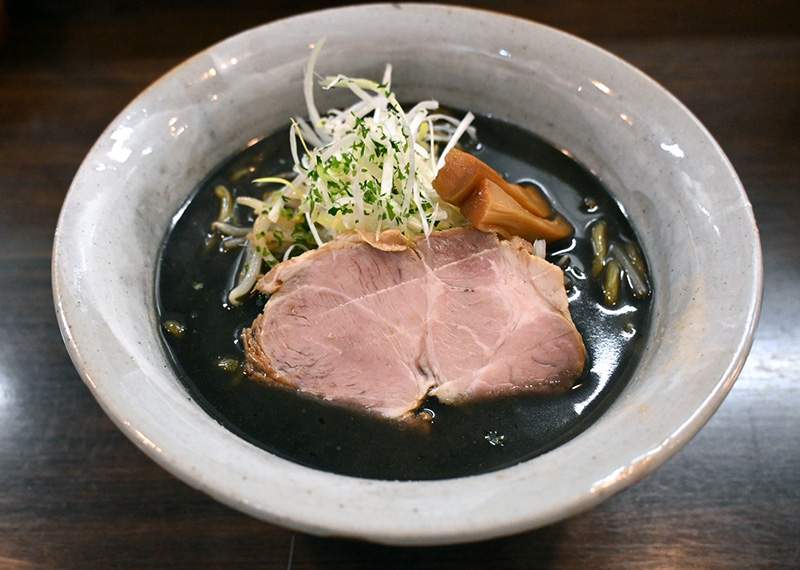
Kuromiso ramen (¥980)
11:30 JST, January 12, 2023
In its heyday as the Kaga Domain’s capital, the castle town of Kanazawa fostered dazzling art and vibrant cultural traditions. And in the culinary arts, beautiful Kaga dishes made with local ingredients took root through ryotei, a kind of exclusive traditional restaurant one often needs a referral to get into. Perhaps because of this history, a ramen culture never developed in the city, now part of Ishikawa Prefecture. That said, things seem to be changing in recent years, as one can see in Taiga, a thriving ramen shop established 11 years ago near JR Kanazawa Station that specializes in miso (soybean paste) ramen and that is also popular among foreign tourists.
-
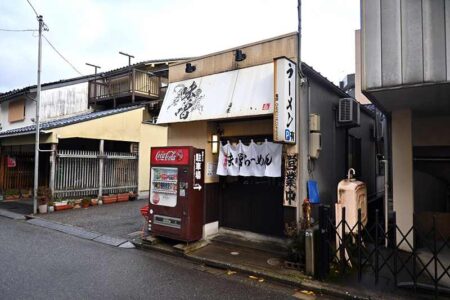
Taiga’s exterior
-
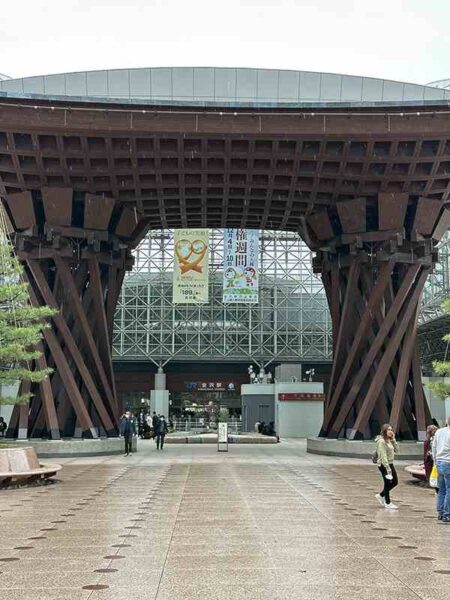
The Tsuzumi-mon Gate, which towers over the east exit of Kanazawa Station, is internationally renowned.
-
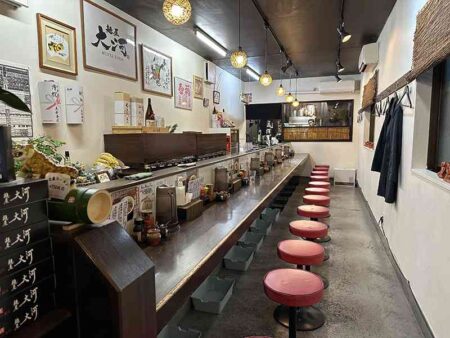
The shop only has counter seats.
The east exit of Kanazawa Station is marked by the Tsuzumi-mon Gate, an impressive wooden structure inspired by the tsuzumi drum of the Noh stage. The shop is a convenient five-minute walk from the gate. I arrived at 3:00 p.m., the end of the lunch hour, to find that there were still customers at the restaurant’s 13-seat counter, including a woman and some couples. If you come around noon, you’ll likely find yourself waiting in line.
The first thing that surprised me when I sat down at the counter was the homemade vegetable juice served. The owner, Yushi Terada, 38, smiled as he came out to the counter and said, “I thought I would try to reduce the spike in blood sugar levels and ease the guilt felt when eating ramen, even if only a little.” Terada further explained, “I don’t know how effective it actually is, but we make it with vegetables and fruits such as apples, carrots and tomatoes.” The drink went down easy, fresh and delicious. And indeed, I already felt a little less guilty.
There is no ticket machine in the shop; customers order from a menu on the counter. The core of the menu consists of three kinds of ramen: miso, kuromiso (black miso) and akamiso (red miso), each priced at ¥850 (Prices have been revised and are now ¥980). After much deliberation, I ordered the kuromiso ramen, which gets its dark coloring from squid ink.
-
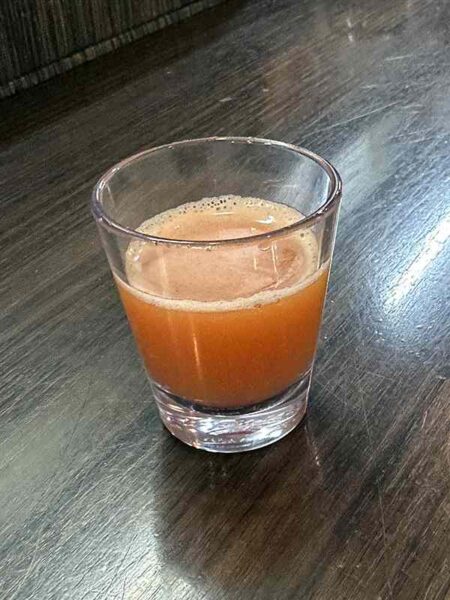
Homemade vegetable juice served before orders of ramen
-
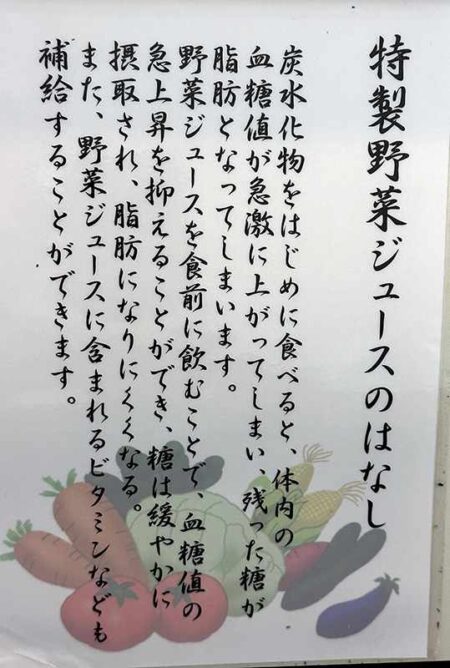
A description of the shop’s homemade vegetable juice
-
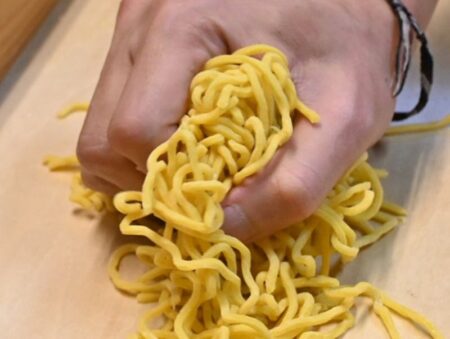
Noodles are hand-kneaded and curled before boiling.
-
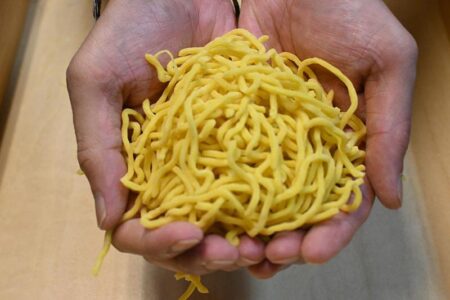
Thick noodles specially ordered from a local noodle factory
In the kitchen, Terada poured lard into a wok and began to vigorously stir-fry some bean sprouts. Fire belched up from the pan. Then he poured miso soup into the wok and repeatedly scooped it back up with a Chinese ladle, bringing it level to his face before dropping it down again. “The lard traps the aroma and umami, and then combines with the soup to make it mellow,” said Terada. The soup is dropped from high to aerate it and further mellow its flavor.
-
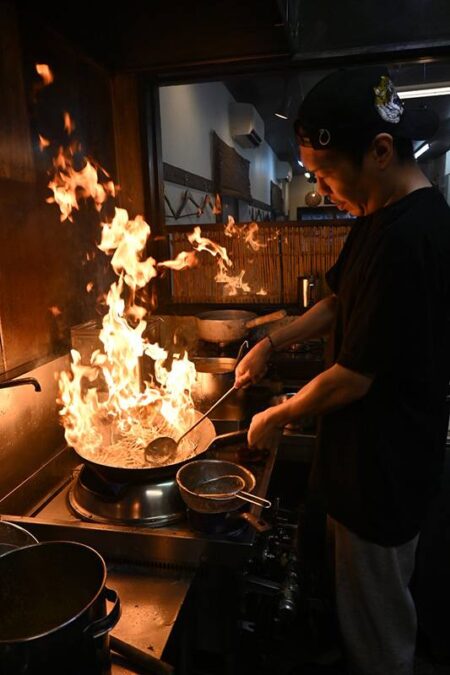
Fire engulfs bean sprouts being stir-fried on a wok.
-

Miso soup is about to be added.
-
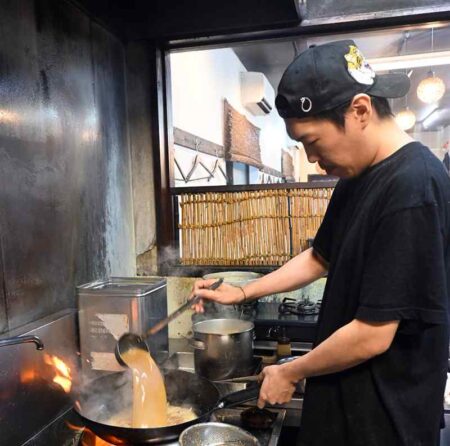
The miso soup is added to the wok.
-
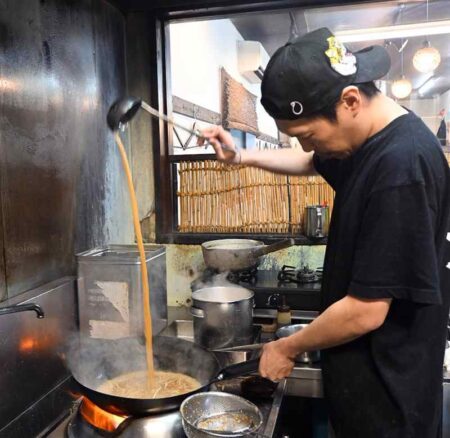
The soup is repeatedly scooped up with a Chinese ladle and brought to face level before being dropped back down.
-
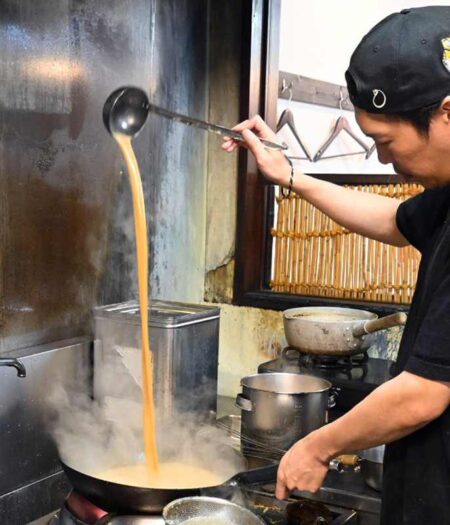
The soup is repeatedly scooped up with a Chinese ladle and brought to face level before being dropped back down.
-
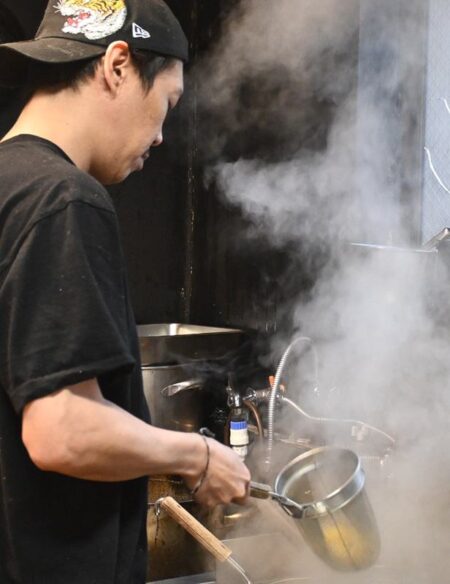
Hot water is drained off the boiled noodles.
-
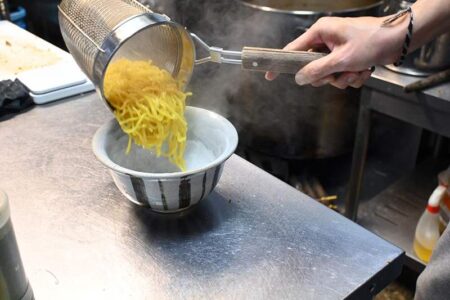
Noodles are put into a bowl.
Once the soup and noodles had been put into the bowl, the squid ink was added. A spoonful or so of the black stuff was mixed in, instantly turning the soup as dark as pitch. The finished kuromiso ramen was placed on the counter in front of me, with broth so black I couldn’t make out the noodles soaking within. The soup was buttery, rich and delicious. The squid ink and miso broth seemed to make a fine pairing, and I could detect no fishy smell at all.
-
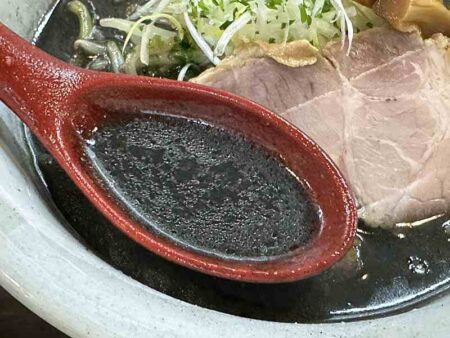
Pitch-black miso soup
-
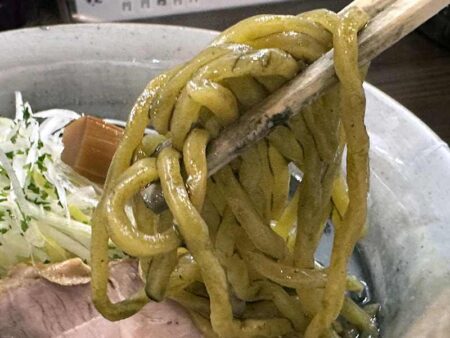
Noodles coated in the black soup
-
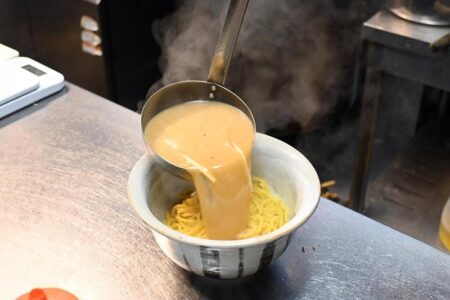
The bowl is filled with soup.
-
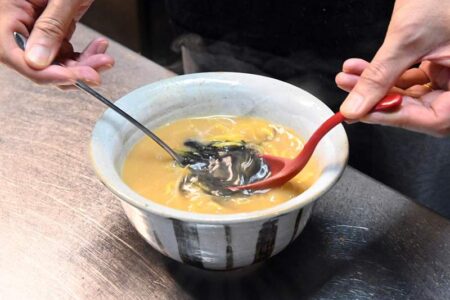
Squid ink is added.
-
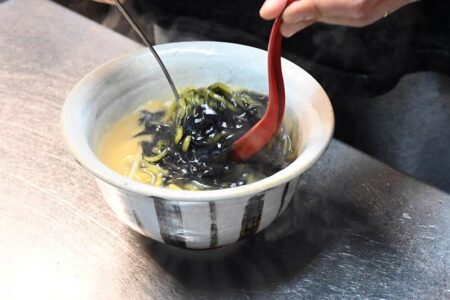
Squid ink quickly turns the soup black.
The dish’s thick noodles, made by a local noodle factory, had a glutinous texture. They are hand-kneaded before they are boiled to make them curly and good for drawing up the soup. “The miso soup is hot, so we use short noodles to make it easier to eat. You end up doing more eating than slurping,” Terada said. The stir-fried bean sprouts added a crunchy note. Other toppings include homemade chashu pork shoulder roast, green onions, thick bamboo shoots, and aonori (green laver). “My theory is that if the noodles are thick, the bamboo shoots should be thick, too,” Terada says. I polished off the ramen with great satisfaction and left the bowl dry.
Opting for Hokkaido miso
-
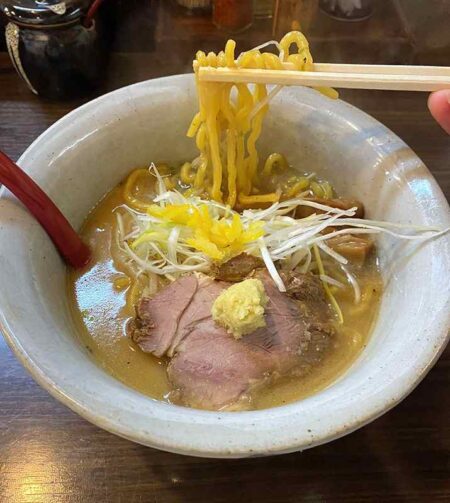
Well-balanced miso ramen
-
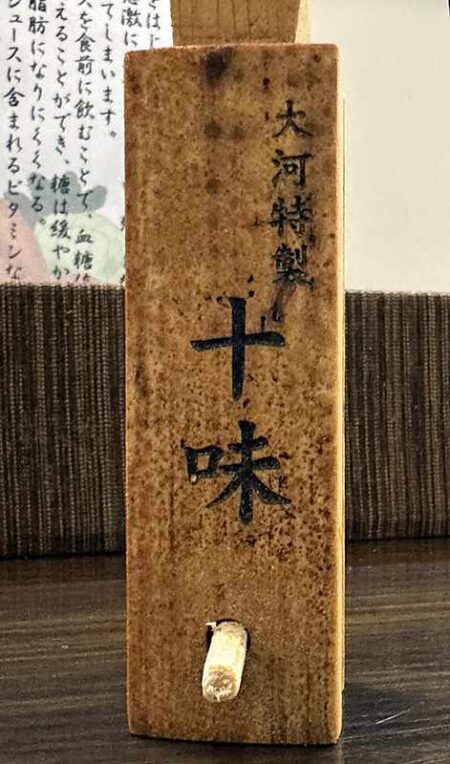
The shop offers its own special ju-mi (ten spices) instead of shichi-mi (seven spices).
-
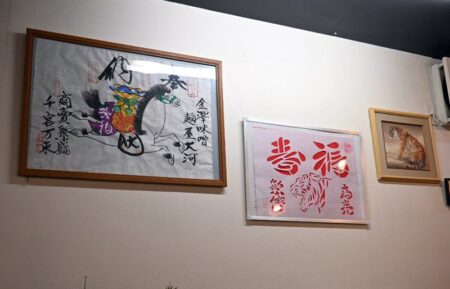
The shop is decorated with many tiger-related pictures and ornaments due to the similar pronunciation for tiger and the shop’s name.
-
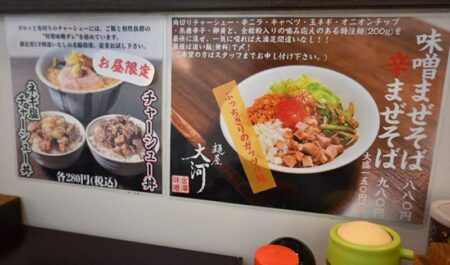
There are also rice bowl options to go with the ramen.
Instead of using local miso, Terada uses miso from Hokkaido as well as Nagano. “Local miso is too flavorful and doesn’t go well with ramen. You’ve really got to have miso from regions where ramen culture is thriving,” he says. To be sure, Hokkaido is awash in outstanding ramen.
The miso is combined with a basic soup made daily from pork genkotsu (knee joints) — which help thicken the soup — chicken bones, momiji (chicken feet), kombu (kelp), dried fish, shiitake mushrooms and other ingredients. When it rains, he says, that’s when you can make a good soup. He’ll make detailed adjustments depending on the day, adding more dried fish, for example, on sunny days.
The basic miso soup is the same for all the shop’s ramen, but the miso, kuromiso and akamiso ramens each have their own unique flavor. Miso, the most popular, is well-balanced and incorporates ginger, yuzu and aonori. The akamiso version is made with shrimp-flavored chili oil and sansho (Japanese pepper) for an aromatic and spicy taste, while the kuromiso iteration is rich in flavor.
Hokuriku Shinkansen freights in customers
-
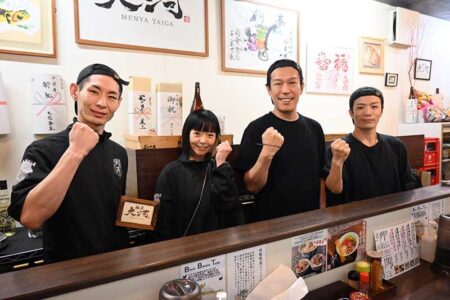
Owner Yushi Terada and staff
-
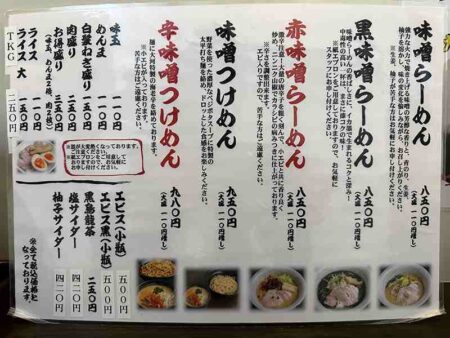
Taiga’s Menu
-
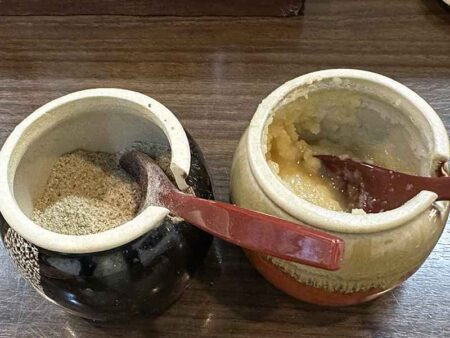
Garlic, right, and pepper sit on the counter.
“I knew the Shinkansen was coming to Kanazawa, but I never expected so many customers,” Terada said.
Terada opened the shop in March 2012, when he was 28 years old. “People around me were all against opening the shop here, saying, ‘Who’s going to come to the Kanazawa Station area?’” he recalls. Nowadays, the station’s neighborhood is prime real estate, but at the time there were not many eateries nearby. As is often the case for prefectural capitals in Japan, residents preferred to go to large shopping malls in the suburbs, and the streets around Kanazawa Station were mostly quiet. That all changed with the opening of the Hokuriku Shinkansen in March 2015, three years after Terada opened his shop. He began to see crowds of tourists and was even interviewed by a Taiwanese TV station.
This was partly because there were not many ramen shops in Kanazawa. Ishikawa Prefecture does have a long-established chain of popular ramen restaurants called “8-ban Ramen,” and in fact the chain is so well known locally that whenever I asked locals about ramen shops on my business trips to Kanazawa, its name always came up. That’s how famous it is in Kanazawa. However, such a narrow range of recommendations just goes to show how few other ramen shops exist in Kanazawa. Despite the odds, Terada decided to have a go at making a living from ramen in the city.
Terada, a native of Hakusan City, Ishikawa Prefecture, worked in many restaurants in his youth, but “ramen shops were the best fit,” he says. He worked at a ramen shop in the Kanazawa central wholesale market for about five years, learned from a famous ramen shop in Tokyo, and happened to meet the then tenants of his current location. The place had been a ramen shop run by an elderly couple, and Terada rented it out, pots and all. In the beginning, he didn’t think too hard about what he was doing.
“I thought I opened my ramen shop in a place that used to be a ramen shop, so customers would come naturally,” Terada said. “I was happy to be able to do what I love, and I was just thinking that as long as I could make a living, it would be fine.” He chose to specialize in miso because he felt that in Kanazawa, where there is no ramen culture, he would not be able to sell the same type of ramen that was already available. Miso just happened to come to mind.
-
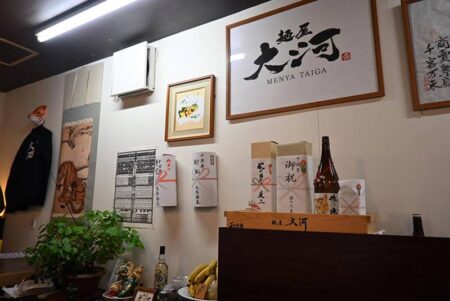
A selection of celebratory sakes from the 10th anniversary celebration of the shop’s opening last March
-
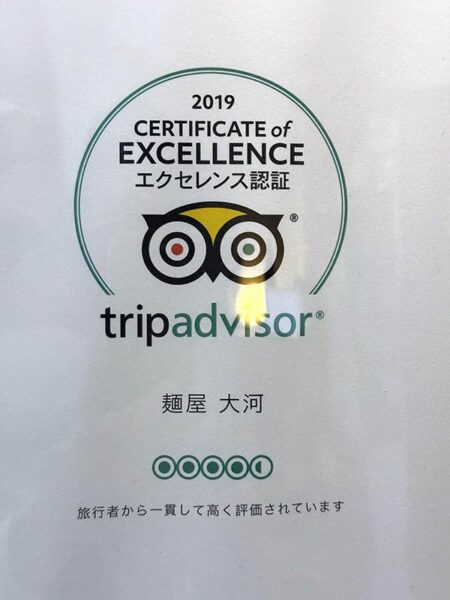
The shop has also received high ratings on TripAdvisor.
-
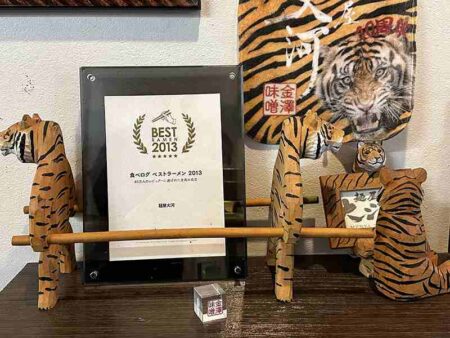
The restaurant was awarded “Best Ramen” by Tabelog in 2013.
Last year, the shop celebrated its 10th anniversary, and it is now a chain, with three shops in the prefecture. Of course, the influx of tourists alone was not enough to achieve such success. The hearts of Hokuriku ramen connoisseurs have been won over by Terada’s commitment to making good ramen. He has kept tweaking, improving the taste, and is still doing so today.
“It’s nice to be recognized by so many people,” Terada said smiling. Someday, ramen might just be a part of Kanazawa’s culture.

Taiga
6-3 Horikawa-cho, Kanazawa City. Lunch: 11:00 a.m. to 3:00 p.m. Dinner: 5:30 p.m. to 11:00 p.m. (closes when soup runs out). No regular holidays.
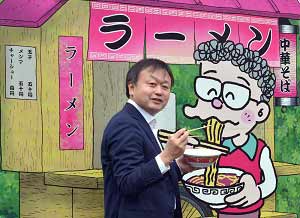
Futoshi Mori, Japan News Senior Writer
Food is a passion. It’s a serious battle for both the cook and the diner. There are many ramen restaurants in Japan that have a tremendous passion for ramen and I’d like to introduce to you some of these passionate establishments, making the best of my experience of enjoying cuisine from both Japan and around the world.
Japanese version
【ラーメンは芸術だ!】イカスミを使った黒味噌ラーメン、北陸新幹線が生んだ繁盛店…金沢「大河」

"JN Specialities" POPULAR ARTICLE
-

The Japan News / Weekly Edition (12/12-12/18)
-
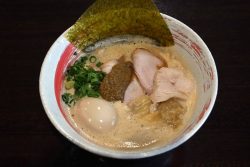
Noodle Dining Shunsai / Rich Oyster Ramen to Savor at Odasaga; Experienced 68-year-old Owner Creates Numerous Ramen Varieties
-

The Japan News / Weekly Edition (12/5-12/11)
-

People Keep Loved Ones’ Ashes Close in Special Jewelry, Small Urns as Unique Way to Memorialize Them
-
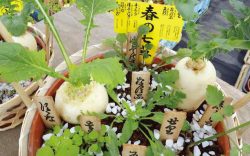
The Japan News / Weekly Edition (12/19-12/25)
JN ACCESS RANKING
-

Tokyo Economic Security Forum to Hold Inaugural Meeting Amid Tense Global Environment
-

Keidanren Chairman Yoshinobu Tsutsui Visits Kashiwazaki-Kariwa Nuclear Power Plant; Inspects New Emergency Safety System
-

Imports of Rare Earths from China Facing Delays, May Be Caused by Deterioration of Japan-China Relations
-

University of Tokyo Professor Discusses Japanese Economic Security in Interview Ahead of Forum
-

Japan Pulls out of Vietnam Nuclear Project, Complicating Hanoi’s Power Plans



